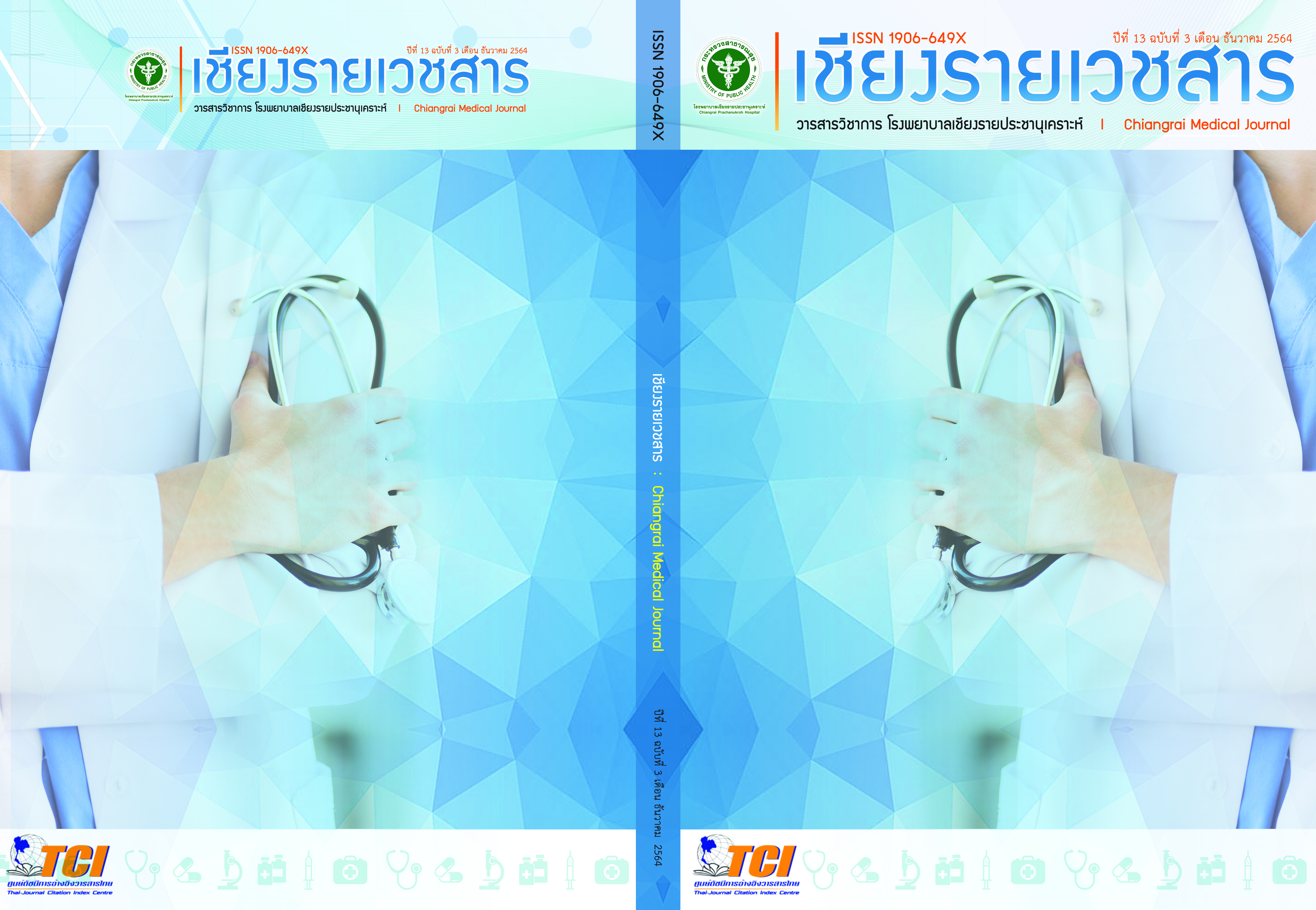CESAREAN SECTION RATE IN MAESAI HOSPITAL USING THE ROBSON CLASSIFICATION SYSTEM
Main Article Content
Abstract
BACKGROUND
Cesarean section rate is increasing in Thailand and around the world. The Robson classification system has been used to classify pregnant women to reduce unnecessary cesarean rate. Previous studies do not have any report from the community hospital. So this study used the Robson classification system to evaluate the cesarean section rate in reducing unnecessary cesarean deliveries in Maesai hospital.
OBJECTIVE
To evaluated cesarean section rate using the Robson classification system.
METHODS
The cross-sectional study of pregnant women who delivered in the labour room at Maesai hospital between August 2018 and July 2020 and evaluated a cesarean section rate each group using the Robson classification system.
RESULTS
A total of 2,005 women who delivered at the labour room of Maesai hospital were classified in the Robson classification system. There was 42 % in group 3 (multiparous, singleton, cephalic, ≥ 37 weeks, spontaneous labour) and 38.65 % in group 1 (nulliparous, single cephalic, ≥ 37 weeks, spontaneous labour). Cesarean section rates in Maesai hospital were 20.25 %. In cesarean delivered group, group 5.1 (one time previous cesarean section, single cephalic, term) was 31.28 % of the total cesarean section rate and group 1 was 26.35 % of the total cesarean section rate.
CONCLUSION AND DISCUSSIONS
Group 5 (previous cesarean section at least one time, single cephalic, term) has more cesarean delivered, so to reduce the cesarean section rate in this group is reducing primary cesarean delivery. Cesarean section should be done by the obstetric indication. Especially cephalopelvic disproportion (CPD) should was be diagnosed correctly because being a main indication of the primary cesarean delivery in Maesai hospital.
Article Details
References
Mei C, Yang W, Wei X, Wu K, Huang D. The Unique Microbiome and Innate Immunity During Pregnancy. Front Immunol 2019;10:2886.
Ye J, Zhang J, Mikolajczyk R, Torloni MR, Gülmezoglu AM, Betran AP. Association between rates of caesarean section and maternal and neonatal mortality in the 21st century: a worldwide population-based ecological study with longitudinal data. BJOG. 2016;123(5):745-53.
Betrán AP, Vindevoghel N, Souza JP, Gülmezoglu AM, Torloni MR. A systematic review of the Robson classification for caesarean section: what works, doesn't work and how to improve it. PLoS One. 2014 3;9(6):e97769.
Robson M. Classification of cesarean sections. Fetal and Maternal Medicine Review 2001;12:23-39.
Betran A, Torloni M, Zhang J, Gülmezoglu A, WHO working group on caesarean section. WHO statement on caesarean section rates. BJOG 2016;123:667–70.
Betran AP, Ye J, Moller AB, Zhang J, Gulmezoglu AM, Torloni MR. The Increasing Trend in Caesarean Section Rates: Global, Regional and National Estimates: 1990-2014. PLoS One. 2016;11(2):e0148343.
Ming Y, Li M, Dai F, Huang R, Zhang J, Zhang L, et al. Dissecting the current caesarean section rate in Shanghai, China. Scientific Reports. 2019;9(1):1-8.
Charoenboon C, Srisupundit K, Tongsong T. Rise in cesarean section rate over a 20-year period in a public sector hospital in northern Thailand. Arch Gynecol Obstet 2013;287(1):47-52.
Yukaew N. Cesarean section rate according to Robson’s classification. Journal of Preventive Medicine Association of Thailand 2560;3:262-71.
Sornsukonrat S. Robson classification: a guide booklet. Bangkok: Rajavithi Hospital; 2018.
Vogel JP, Betrán AP, Vindevoghel N, Souza JP, Torloni MR, Zhang J, et al. Use of the Robson classification to assess caesarean section trends in 21 countries: a secondary analysis of two WHO multicountry surveys. Lancet Glob Health 2015;3(5):e260-70.
Beck S, Wojdyla D, Say L, Betran AP, Merialdi M, Requejo JH, et al. The worldwide incidence of preterm birth: a systematic review of maternal mortality and morbidity. Bull World Health Organ 2010;88(1):31-8.
Howson CP, Kinney M, Lawn JE, editor. March of Dimes, PMNCH, Save the Children, WHO. Born Too Soon: the global action report on preterm birth. Geneva: World Health Organization;2012.
Liu S, Liston RM, Joseph KS, Heaman M, Sauve R, Kramer MS, et al. Maternal mortality and severe morbidity associated with low-risk planned cesarean delivery versus planned vaginal delivery at term. CMAJ 2007;176(4):455-60.
Barber EL, Lundsberg LS, Belanger K, Pettker CM, Funai EF, Illuzzi JL. Indications contributing to the increasing cesarean delivery rate. Obstet Gynecol 2011;118(1):29-38.
Wu Y, Kataria Y, Wang Z, Ming WK, Ellervik C. Factors associated with successful vaginal birth after a cesarean section: a systematic review and meta-analysis. BMC Pregnancy Childbirth 2019;19(1):360.
Zhang J, Landy HJ, Ware Branch D, Burkman R, Haberman S, Gregory KD, et al. Contemporary patterns of spontaneous labor with normal neonatal outcomes. Obstet Gynecol. 2010;116(6):1281-7.
Caughey AB, Cahill AG, Guise JM, Rouse DJ. Safe prevention of the primary cesarean delivery. Am J Obstet Gynecol 2014;210(3):179-93.
Arulkumaran S, Koh CH, Ingemarsson I, Ratnam SS. Augmentation of labour--mode of delivery related to cervimetric progress. Aust N Z J Obstet Gynaecol 1987;27(4):304-8.
Rouse DJ, Owen J, Hauth JC. Active-phase labor arrest: oxytocin augmentation for at least 4 hours. Obstet Gynecol 1999;93(3)323-8.
Berhan Y, Haileamlak A. The risks of planned vaginal breech delivery versus planned caesarean section for term breech birth: a meta-analysis including observational studies. BJOG. 2016;123(1):49-57.
Gibson KS, Waters TP. Measures of success: prediction of successful labor induction. Semin Perinatol. 2015;39(6):475-82.
Thanh BYL, Lumbiganon P, Pattanittum P, Laopaiboon M, Vogel JP, Oladapo OT, et al. Mode of delivery and pregnancy outcomes in preterm birth: a secondary analysis of the WHO Global and Multi-country Surveys. Sci Rep 2019;9(1):15556.


